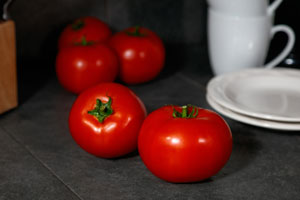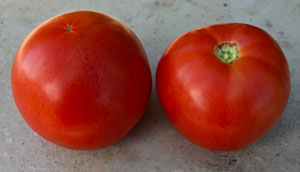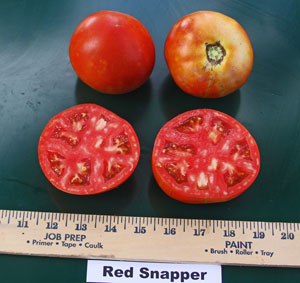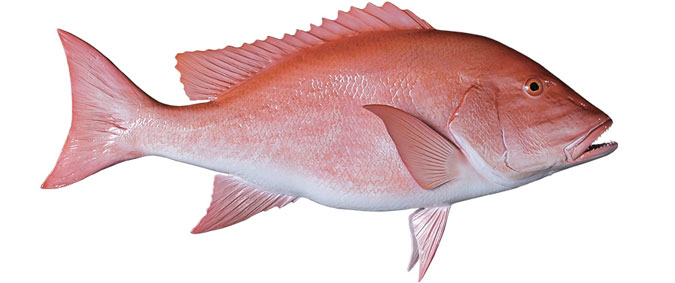|
Rodeo Tomato for 2020 – Red Snapper
By Calvin Finch, Retired Horticulturist for Texas A&M Agrilife Extension Service
Each year a Texas A&M AgriLife Extension Service team led by horticulturists David Rodriguez and Larry Stein Ph.D. assisted by the Bexar Master Gardeners and Dr Jerry Parsons tests a number of varieties of tomatoes to select one to be designated the San Antonio Rodeo Tomato for the year. Among those tomatoes brought to the local market in this manner were Celebrity, BHN 968, Valley Cat, Tycoon, and -Red Deuce. Last year the Harris Moran 8849 was the Rodeo Tomato.
This year the selection is the Red Snapper. Red Snapper is a heat setting determinate selection that produces a generous amount of large, deep red colored fruit. Being determinate means that it grows quickly to a full-size plant and then concentrates on producing and maturing fruit.
Being a heat setter means that it can set fruit even when temperatures are relatively hot.
As the designated Rodeo Tomato for 2020 the Red Snapper will be offered in 4.5 inch and 1-gallon containers at the Rodeo by the Bexar County Master Gardeners in their exhibits in the HEB Little Buckaroo Farm tent. It will also be offered by some retail nurseries with part of the income donated to the youth gardening effort in Bexar County.
The Rodeo begins on February 6, so it is too early to plant the tomato transplants purchased at the Event in our cool winter soil. Plan on potting up the Red Snapper transplants and any other tomatoes you purchase now. Potting up involves obtaining a one or 3-gallon plastic container filled with Osmocote enriched potting mix. Place the potted-up tomatoes in the sun sheltered from the wind. If temperatures are forecast to be lower than 40 degrees move the pots into the house or another warm area until warmer weather returns.
The tomato transplants if they are placed in cold soil will stop growing. If they are potted up under the conditions described, they will continue growing and will be ready to produce tomatoes when they are planted in the garden. The tomatoes identified as the first tomatoes of the season in suburban and rural newspapers are often potted up tomatoes.
To be safe plan on planting some of the potted-up tomatoes in the garden about March 1, most after March 15, and the rest on or after April 1.
Prepare the garden soil with 2 inches of compost and 10 cups of slow-release lawn fertilizer incorporated in the soil of every 100 sq. ft. of bed. Support a large crop of fruit by placing each of the tomato plants in a tomato cage in full sun. Mulch also contributes to successful production, especially if you wait until mid-April to apply it so the soil can warm up. My favorite mulch for tomatoes is live oak leaves.
The Red Snapper as a high performance 2020 Rodeo Tomato promises to produce well in most Central Texas conditions but it is not nematode resistant. If a portion or all your garden is infested with nematodes use one of the previous Rodeo tomatoes (Celebrity, Tycoon, BHN 968, or Valley Cat) that is nematode resistant. If you have had problems with spider mites in past years, this year apply a preventative spray of 2 tablespoons in a gallon of water of seaweed extract under the leaves every week.
Seed of ‘Red Snapper’ can be purchased from:
At: HOSS Seed https://hosstools.com/product/red-snapper-tomato
Stokes seed https://www.stokeseeds.com/us/red-snapper-vf-aal-hybrid-bush-tomato
Disease Resistance:
HR = High resistance: Aal / Fol: 1, 2 / Va: 1 / Vd: 1
Key to Resistance Codes
CODE DISEASE PATHOGEN
Aal Alternaria stem canker Alternaria alternata f. sp. lycopersici
Fol Fusarium wilt Fusarium oxysporum f. sp. lycopersici
For Fusarium crown & root rot Fusarium oxysporum f. sp. radicis-lycopersici
Va Verticillium wilt Verticillium albo-atrum
Vd Verticillium wilt Verticillium dahlia
Disease Resistance:
IR = Intermediate resistance: Ss / TSWV / TYLCV
Ss Gray leaf spot Stemphylium solani
TSWV - Tomato spotted wilt Tomato spotted wilt tospovirus
TYLCV: Is Tomato yellow leaf curl Tomato yellow leaf curl bigeminivirus (Israel strain)
Resistance Terminology
HR = High resistance: plant varieties that highly restrict the growth and development of the specified pest or pathogen under normal pest or pathogen pressure when compared to susceptible varieties. These plant varieties may, however, exhibit some symptoms or damage under heavy pathogen or pest pressure.
IR = Intermediate resistance: plant varieties that restrict the growth and development of the specified pest or pathogen, but may exhibit a greater range of symptoms or damage compared to “highly resistant” varieties. Intermediately resistant plant varieties will still show less severe symptoms or damage than susceptible plant varieties when grown under similar environmental conditions and/or pathogen or pest pressure.
T = Tolerance: The ability of a plant variety to endure abiotic stress without serious consequences for growth, appearance and yield.

Tomato Red Snapper
|

Tomato Red Snapper
|

Tomato Red Snapper
|

Red Snapper Fish
|
|
|
|



